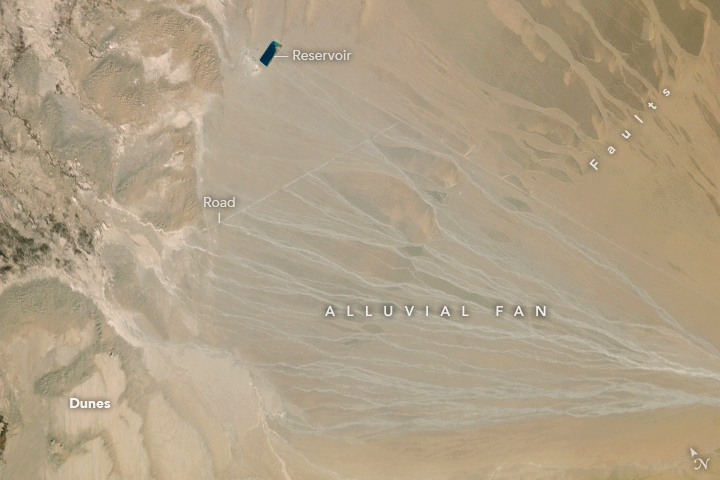Alluvial Fan, Taklimakan Desert
Taken by the EarthKAM Mission on the International Space Station, this photograph shows numerous radial river channels on a large alluvial fan in the Taklimakan Desert. This is the active part of the fan, with several light-toned channels carrying water. The water flows into the desert from the snow-covered Kunlun Mountains to the south. The modern fan is 65 kilometers (40 miles) long, and its channels end in fields of dunes.
Population density is very low in this remote, dry region of western China. The only signs of people are two straight roads and a small reservoir, which supplies water to a small area of crops just outside the top of the image. (For scale, the reservoir is about 2 kilometers long.) In contrast, similar alluvial fans just to the west host major population centers and are covered with dense green fields, as seen from space.
The smooth fan surface is disrupted by elongated hills. These are older, lithified fan sediment deposits that have been pushed up from the subsurface along geologic faults. Vertical rock movements along faults result from the tectonic forces that are presently building the Kunlun Mountains.
EarthKAM (Earth Knowledge Acquired by Middle school students) photograph CCFID_155475_2017306054734 (//images.earthkam.org/main.php?g2_itemId=856001) was acquired on November 2, 2017, with a Nikon D2Xs digital camera using a 180 mm lens, and is provided by Sally Ride EarthKAM@Space Camp on the International Space Station. The caption is provided by the Earth Science and Remote Sensing Unit, NASA Johnson Space Center. EarthKAM is a NASA educational outreach program that enables students, teachers, and the public to learn about Earth from the unique perspective of space. During Sally Ride EarthKAM missions, middle school students around the world request images of specific locations on Earth. The image in this article has been enhanced to improve contrast. Caption by M. Justin Wilkinson, Texas State University, Jacobs Contract at NASA-JSC.


